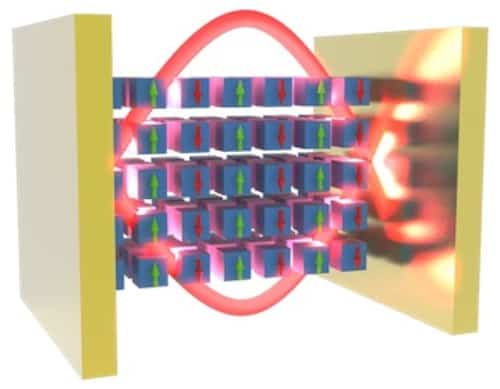Half-light, half-matter quasiparticle appears in a van der Waals magnet


A new quasiparticle that is part matter, part light has emerged in experiments by researchers at the City College of New York, US, who observed it by coupling light to a stack of ultrathin two-dimensional antiferromagnets. The work could have implications for devices like lasers or for digital data storage.
Coupling light strongly to matter is a well-known way of engineering properties such as magnetism, superconductivity and ferroelectricity in quantum materials. One way to do this is by setting up interactions between elementary particles and optical microcavities, which are structures in which light is reflected back and forth between two or more mirrors.
Strongly coupling photons with spin-correlated excitons
In the new work, researchers led by Vinod Menon studied a material with the chemical formula NiPS3. This material belongs to a chemical family known as the transition metal thiophosphates, and condensed-matter physicists know it as a van der Waals (vdW) magnetic insulator – that is, a two-dimensional material containing strongly correlated particles that give rise to a variety of electronic and magnetic phases.
When the researchers placed a stack of ultrathin NiPS3 layers within an optical microcavity, they observed a strong coupling between spin-correlated excitons (quasiparticles made of electron-hole pairs) in the material and photons trapped between the cavity’s mirrors. This photon-exciton coupling gave rise to a previously unobserved type of quasiparticle known as an exciton-polariton that has properties of excitons, photons and spins.
Part light, part matter
As these new quasiparticles are, in effect, “part light”, they behave like photons in many respects, says Florian Dirnberger, who is the lead author of a paper in Nature Nanotechnology on the work. “Their matter part, however, stems from a magnetic material, so its properties are strongly tied to the antiferromagnetic order of the material,” he adds. “This gives rise to strong linear polarization.”

Anomalous Josephson effect appears in a topological insulator
According to the researchers, this approach of interfacing light with magnetic materials is a promising path toward efficient magneto-optical effects that could have applications in lasers and in digital data storage. What is more, the new class of magnetic quasiparticles could be used for quantum transduction through interactions between low frequency magnons (collective oscillations of the spin magnetic moments of a material), high frequency excitons and visible light.
Members of the team say they now plan to extend their study in an attempt to better understand the role of the quantum electrodynamic vacuum when quantum materials are placed into optical cavities. They hope to realize novel quantum phases of matter that have no counterpart in the classical (thermodynamic equilibrium) regime.



